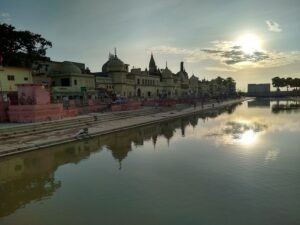Nestled on the banks of the sacred Sarayu River in the northern part of India, Ayodhya stands as a testament to the country’s ancient and diverse cultural heritage. Revered as the birthplace of Lord Rama, a central figure in the Hindu epic Ramayana, Ayodhya’s history is intertwined with mythology, spirituality, and a tapestry of historical events. With a legacy spanning thousands of years, Ayodhya has witnessed the rise and fall of empires, the construction of grand temples, and the ebb and flow of religious and cultural influences.
A Glimpse into the Rich History of Ayodhya
Ancient Origins:
The origins of Ayodhya can be traced back to the Treta Yuga, an era in Hindu cosmology. According to Hindu mythology, Ayodhya was founded by the legendary King Manu, the progenitor of humanity. The city’s prominence heightened during Ikshvaku dynasty’s reign that Lord Rama belonged to. The great sage Valmiki immortalized the city’s significance in the epic Ramayana, narrating the life and adventures of Lord Rama.
The Ramayana and Ayodhya:
The Ramayana by Valmiki is an honest cornerstone of the Hindu literature and of course, mythology. It recounts the life of Prince Rama, his exile, the abduction of his wife Sita by the demon king Ravana, and the subsequent epic battle between Rama and Ravana. Ayodhya serves as the starting point of this epic, where Rama is born to King Dasharatha.
The construction of the city, as described in the Ramayana, is an awe-inspiring tale of divine architecture. It is said that Lord Brahma, the creator in Hindu cosmology, guided the celestial architect Vishwakarma in building the magnificent city. The grandeur of Ayodhya, as depicted in the Ramayana, has inspired countless artists, poets, and devotees over the centuries.
Historical Evolution:
Ayodhya’s history extends beyond its mythical origins. Over the centuries, the city witnessed the rise and fall of various empires, including the Mauryas, Guptas, and the Delhi Sultanate. Each dynasty left its imprint on Ayodhya, contributing to its cultural mosaic.
During the medieval period, Ayodhya faced numerous invasions and witnessed the construction of religious structures that reflected the changing religious landscape. The most notable among these was the Babri Masjid, built by the Mughal emperor Babur in the 16th century. The mosque became a focal point of historical and religious significance, ultimately leading to a contentious chapter in Ayodhya’s history.
The Babri Masjid Controversy:
The Babri Masjid, standing in Ayodhya for centuries, became a source of tension in the late 20th century. The dispute over the site’s religious identity escalated, leading to a series of legal battles and socio-political unrest. In 1992, the mosque was demolished by a group of activists, sparking widespread controversy and communal tensions.
Legal Resolutions and Reconciliation:
In the subsequent years, legal battles ensued to determine the rightful ownership of the Ayodhya site. The Supreme Court of India, in a landmark judgment in 2019, resolved the dispute by allocating the site for the construction of a Hindu temple dedicated to Lord Rama. The decision aimed to foster religious harmony and heal the wounds of the past.
Modern Ayodhya:
In recent years, Ayodhya has undergone transformative changes, with efforts to revive its cultural and spiritual heritage. The construction of the Ram Mandir (temple) at the disputed site has become a symbol of national unity and religious inclusivity. Pilgrims and tourists from across the globe visit Ayodhya to witness the architectural marvels, participate in religious ceremonies, and immerse themselves in the city’s rich history.

History of Ayodhya Conclusion:
Ayodhya’s history is a fascinating tapestry woven with threads of mythology, ancient civilizations, and the complexities of modern socio-political dynamics. As the city continues to evolve, it stands as a beacon of cultural resilience, religious tolerance, and historical significance. Ayodhya’s journey from the pages of the Ramayana to the present day is a testament to the enduring spirit of a city that has played a pivotal role in shaping India’s cultural and religious landscape.
https://columnofindia.com/india-name-change-india-to-bharat/